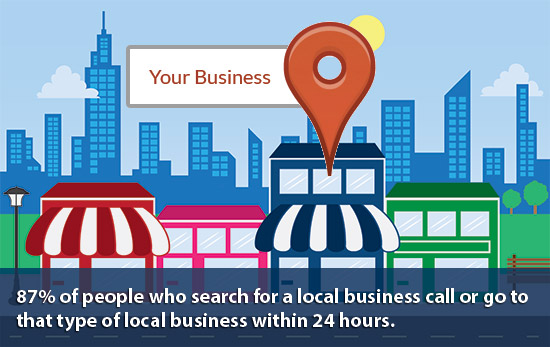As small business owners, many of you might be wondering how to do local SEO. As busy business owners, you might not have the time or the skill to work on technical improvements of your website or creating backlinks to your website. However, it is worth every bit of your effort to learn Local SEO. SEO for local search is the fastest and the most cost effective way to bring traffic to your website organically.
How to do local SEO - Learn local SEO using these 12 simple steps
1. Research good keywords specific to your niche and target area
Do you know that what we think is the best keyword for our business may not be the one which most people are searching for in Google. For example if you are a carpet cleaning company in London, you might think that most people will be searching for the term “Carpet Cleaning Company in London”. But, if you go to Google Adwords, keyword planner tool, you would realise that Carpet Cleaning Company in London has only 10 monthly searches. Whereas, Carpet Cleaning London has 2,900 monthly searches. So, naturally, Carpet Cleaning London is a better keyword for your business. Always remember to perform good SEO keyword research before you start optimising your site for local seo.
2. Have a URL with the location name and the keyword you are targeting
One of the key aspects of local SEO is proper URL. For example if you are a wedding photographer in Orlando Florida, and you are targeting keyword “Orlando Wedding Photographer”, then you should have the URL as www.yourdomain.com/orlando-wedding-photographer
3. Title Tag, Header Tag and Alt Tag
Always have your keyword in the title tag, H1 and H2 tag and image Alt tags. Keep the Keyword at the beginning of the tags.
To check this, go to any website: say www.forbes.com. Right click on any area of the homepage. Click on the option which says "View Page Source". It will open the HTML code for the webpage. You can check the <title> tag, <h1> tag, <h2> tag, <alt> tag for the website.
If you have access to your HTML file or Wordpress Admin, then it is best if you can learn how to optimise the HTML tags yourself. This way, you do not need to hire a developer to make small changes, yet keep your website properly optimised for seo for local search.
4. Create content on the page of at least 600 words
However, I would recommend to have the content around 1000 words. Write meaningful content that shows your knowledge and authority in your domain.
5. Create Separate pages for separate services and separate locations
For example, if you offer both Wedding Photography Services and Wedding Videography services in London, then have 2 separate pages each targeting 1 keyword. Most businesses end up using the same page to write about all of their services. Also, if you have businesses in 2 different regions, create separate page (with a separate URL) for each region. For example if you offer Wedding Photography Services in London, and Wedding Photography Services in Havant, then you should have separate pages for each.
6. Use the keyword in the content at least 2% - 3% of the total no. of words
The only caveat to this is, do not stuff the keywords unnecessarily. If you manage to write content of 600 words plus having the keyword appear 12 times is no big a deal. But make sure that the keyword does not sound too unnatural when you read the entire sentence.
7. Use Bold or Italics on your target keywords
Following on from earlier point, if you are using your target keyword throughout your article, make the keywords in bold or italics at least for some of them. However, do not over do it.
8. List in Google Places
One of the most important aspects of Local SEO is Google Business Listing. Create a Google+ Local page of your business, verify it. Use proper keywords in the Google Plus listing as well.
9. Have a location/contact us page that has the same data as Google+
Make sure that the Name, Address, Phone Number and Hours of Operation Data that you supply in your Google+ page is also on your website under a separate contact us/location page
10. Blog Regularly
Blog posting is a great way of getting visitors to your website for 2 reasons:
a. More frequently you post a blog, more frequently will Google Crawlers come to your website. More it indexes your site, higher the odds that it will rank you higher
b. Blog posts help you to target keywords you are looking to rank for. You can create tons of articles around the same keyword and thus the chances are much higher that Google will start ranking your articles.
c. Blog posts establishes your credibility with your prospects and within your industry as a thought leader and as an authority. When people share your posts on social media, you will automatically get more visitors to your site.
11. Interlink your pages using contextual anchor text
Google crawlers crawls a website through interlinking between pages. So, make sure all your pages are connected to one another page using contextual keyword. For, eg, refer to point no. 6. We have used Google Business Listing as a contextual anchor text and linked to another article.
12. URL structure
Use hyphenated URL structure and all in small letters. Do not use underscore or combine words together. For eg, it is better to have www.yourdomain.com/orlando-wedding-photographer
as opposed to www.yourdomain.com/orlando_wedding_photographer or www.yourdomain.com/orlandoeddingphotographer or www.yourdomain.com/Orlando-Wedding-Photographer
These 12 steps should give you a better understanding of How to do Local SEO? You can learn local SEO if you diligently follow these steps on your website for about 2-3 months. As small business owners, SEO for local search is a highly cost effective way to build your brand online.
What do you think are your biggest online challenges as small business owners? Would love to hear your views on it. Please do drop your comments below.





